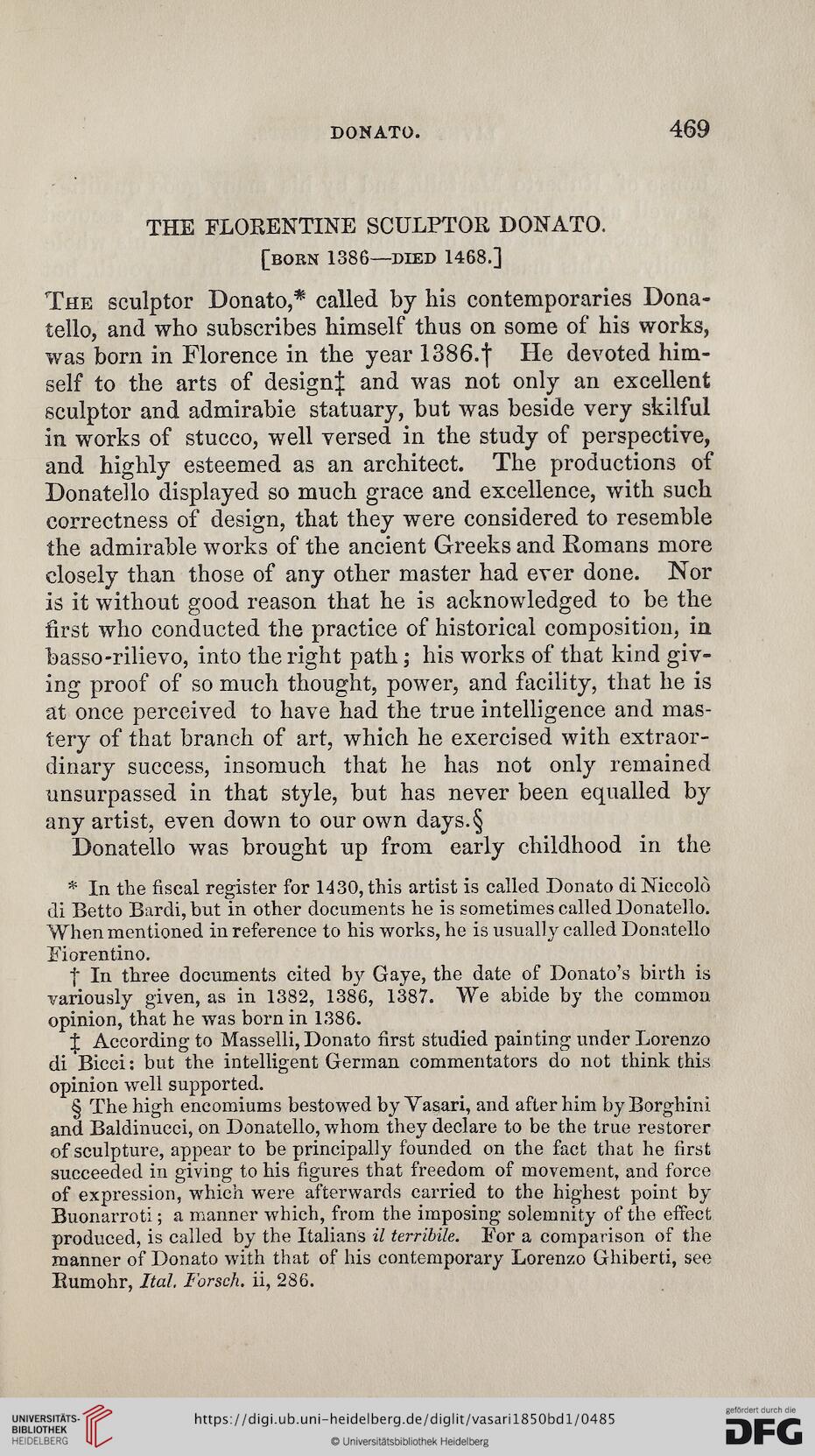DONATO.
469
THE FLORENTINE SCULPTOR DONATO.
[born 1386—died 1468.]
The sculptor Donato,* called by his contemporaries Dona-
tello, and who subscribes himself thus on some of his works,
was born in Florence in the year ISSG.f He devoted him-
self to the arts of design^ and was not only an excellent
sculptor and admirable statuary, but was beside very skilful
in works of stucco, well versed in the study of perspective,
and highly esteemed as an architect. The productions of
Donatello displayed so much grace and excellence, with such
correctness of design, that they were considered to resemble
the admirable works of the ancient Greeks and Romans more
closely than those of any other master had ever done. Nor
is it without good reason that he is acknowledged to be the
first who conducted the practice of historical composition, in
basso-rilievo, into the right path; his works of that kind giv-
ing proof of so much thought, power, and facility, that he is
at once perceived to have had the true intelligence and mas-
tery of that branch of art, which he exercised with extraor-
dinary success, insomuch that he has not only remained
unsurpassed in that style, but has never been equalled by
any artist, even down to our own days.§
Donatello was brought up from early childhood in the
* In the fiscal register for 1430, this artist is called Donato diNiccold
di Betto Bardi, but in other documents he is sometimes called Donatello.
When mentioned in reference to his works, he is usually called Donatello
Fiorentino.
f In three documents cited by Gaye, the date of Donato’s birth is
variously given, as in 1382, 1386, 1387. We abide by the common
opinion, that he was born in 1386.
J According to Masselli, Donato first studied painting under Lorenzo
di Bicci: but the intelligent German commentators do not think thus
opinion well supported.
§ The high encomiums bestowed by Vasari, and after him byBorghini
and Baldinucci, on Donatello, whom they declare to be the true restorer
of sculpture, appear to be principally founded on the fact that he first
succeeded in giving to his figures that freedom of movement, and force
of expression, which were afterwards carried to the highest point by
Buonarroti; a manner which, from the imposing solemnity of the effect
produced, is called by the Italians il terribile. For a comparison of the
manner of Donato with that of his contemporary Lorenzo Ghiberti, see
Rumohr, Ital. Forsch. ii, 286.
469
THE FLORENTINE SCULPTOR DONATO.
[born 1386—died 1468.]
The sculptor Donato,* called by his contemporaries Dona-
tello, and who subscribes himself thus on some of his works,
was born in Florence in the year ISSG.f He devoted him-
self to the arts of design^ and was not only an excellent
sculptor and admirable statuary, but was beside very skilful
in works of stucco, well versed in the study of perspective,
and highly esteemed as an architect. The productions of
Donatello displayed so much grace and excellence, with such
correctness of design, that they were considered to resemble
the admirable works of the ancient Greeks and Romans more
closely than those of any other master had ever done. Nor
is it without good reason that he is acknowledged to be the
first who conducted the practice of historical composition, in
basso-rilievo, into the right path; his works of that kind giv-
ing proof of so much thought, power, and facility, that he is
at once perceived to have had the true intelligence and mas-
tery of that branch of art, which he exercised with extraor-
dinary success, insomuch that he has not only remained
unsurpassed in that style, but has never been equalled by
any artist, even down to our own days.§
Donatello was brought up from early childhood in the
* In the fiscal register for 1430, this artist is called Donato diNiccold
di Betto Bardi, but in other documents he is sometimes called Donatello.
When mentioned in reference to his works, he is usually called Donatello
Fiorentino.
f In three documents cited by Gaye, the date of Donato’s birth is
variously given, as in 1382, 1386, 1387. We abide by the common
opinion, that he was born in 1386.
J According to Masselli, Donato first studied painting under Lorenzo
di Bicci: but the intelligent German commentators do not think thus
opinion well supported.
§ The high encomiums bestowed by Vasari, and after him byBorghini
and Baldinucci, on Donatello, whom they declare to be the true restorer
of sculpture, appear to be principally founded on the fact that he first
succeeded in giving to his figures that freedom of movement, and force
of expression, which were afterwards carried to the highest point by
Buonarroti; a manner which, from the imposing solemnity of the effect
produced, is called by the Italians il terribile. For a comparison of the
manner of Donato with that of his contemporary Lorenzo Ghiberti, see
Rumohr, Ital. Forsch. ii, 286.




